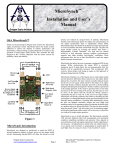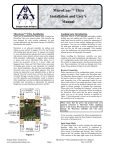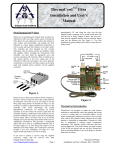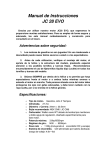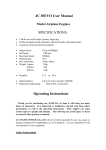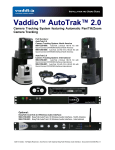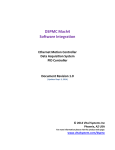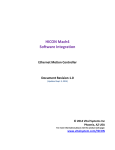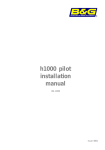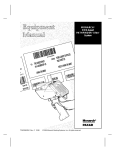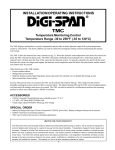Download Installation Guide and User`s Manual MicroSynch Pro
Transcript
MicroSynch TM Pro Installation Guide and User’s Manual OSA MicroSynch™ Pro Thank you for purchasing the Oregon Scale Aviation Inc. MicroSynch Pro engine synchronizer system. MicroSynch Pro (MSP) allows the model aviation enthusiast to achieve the ultimate in realism, performance and functionality, while providing unprecedented safety in the operation of multi-engine model aircraft. MicroSynch Pro provides extensive EMI filtering on a 4 layer board to essentially eliminate electrical noise and hazardous high voltage spikes generated in today’s ignition systems. It has been specifically designed to allow the use of “Tachometer Outputs” from ignition systems, even if the ignition is running from a separate battery and at a different voltage. This means if you are running a gas system that already has ignition sensors, there is no need to add additional sensors or magnets for MicroSynch Pro. MicroSynch Pro eliminates two of the largest risks to multi-engine model aircraft operation; differential thrust induced yaw and engine failure induced loss of control. The most common non-pilot induced reason for the loss of twin engine model aircraft is the failure of an engine under high throttle conditions (typically take-offs or aborted landing attempts) and during the prolonged low throttle condition experienced in the landing approach. If the model is operated while several other aircraft are in the air or running in the pit area, the pilot may not even be aware of the failure until the aircraft has already entered a catastrophic spin or roll. In the event of an engine failure, MicroSynch Pro will instantly respond to the failure by throttling back the good engine. Throttling back automatically insures the pilot can maintain reasonably straight and level flight until regaining control of the remaining engine by reducing the throttle stick below the failsafe threshold. The pilot can then carefully bring the aircraft “home” with full control over the remaining engine, knowing that significant rudder control may be necessary to control the yaw induced by single engine operation. Figure 1 MicroSynch Pro Introduction MicroSynch Pro was designed to synchronize the RPM of engines or motors on twin engine model aircraft. Maintaining matched RPM allows the aircraft to avoid adverse yaw induced by unequal thrust. In addition, MicroSynch Pro monitors and continuously adjusts the engines for synchronization. If one engine unexpectedly stops or significantly reduces RPM, MicroSynch Pro reduces the throttle of the functional engine automatically to avoid a hazardous and often aircraft-fatal snap spin. The pilot can regain throttle control by lowering the throttle stick below a user programmable “Failsafe Threshold”. MicroSynch Pro also allows the user to program a minimum RPM limit. While synchronizing, the engine RPM is continuously Oregon Scale Aviation Inc. www.oregonscaleaviation.com monitored, and if it drops below the user programmable limit, the throttle for that engine will be automatically increased. This OSA exclusive feature helps avoid losing an engine on final approach or during prolonged periods of idling. Page 1 MicroSynch Pro is easy to install and adjust. The on-board LEDs provides feedback under both programming and operational conditions simplifying installation and operation. Once adjusted to a particular aircraft, further adjustment is unnecessary. All adjustments are stored in non-volatile memory, so no special stick movements or programming are required prior to each flight. Once it is setup, it is truly a “start it and fly it” system. MicroSynch Pro Installation Before installing the controller, it is recommended that you complete the “normal” installation of the throttle servos and radio in your aircraft. Try to use near 100% throws to minimize mechanical slop and to better match the programming of the MicroSynch Pro. You should complete all full throttle and idle adjustments (both mechanical and transmitter adjustments), and as a safety measure, insure that you can MicroSynch Pro Installation and User’s Manual Doc # MSP1003 stop both engines by reducing the throttle stick and throttle trim tab to their lowest positions (or with a separate Tx kill switch). For best performance adjust the engines to run at roughly the same RPM when slightly above idle. This can be measured with a tachometer. Once you have completed the “normal” aircraft radio and servo installation and throttle adjustments, you can then proceed with the MicroSynch Pro installation. Connect the receiver throttle output to the MicroSynch Pro input as shown in Figure 2. This requires a male to male connector for your radio system. If you cannot purchase a male to male connector, you can build one using an aileron extender and the supplied connector. Please refer to the “Connector Installation” section at the end of this document for details. Always insure correct polarity as shown in Figure 1. Figure 3 Best Method Figure 4 Alternate Method Highlighted face towards magnet Highlighted face towards magnet System Connection Diagram Figure 2. Installing RPM Sensors Using Tachometer Outputs If using the Tachometer outputs, you will need to use an aileron or servo extension cable to connect to the MicroSynch Pro. If you plan to use an optical kill switch that switches the ground line (like the Rcexl Opto Gas Kill Switch) do not connect the ground line of the extension cable, only connect the power and signal line. Plug one extension cable in, turn on the receiver/MicroSynch Pro controller and then the ignition system. Grasp the propeller firmly with a gloved hand, and very slowly move the magnet past the sensor. Remember, the ignition system is live, and if you move the propeller too quickly, the engine will kick. The LED should blink only one time as you move the magnet past the propeller. Once you verify the LED blinks, turn the system off, and remove the Tachometer Output cable and plug in the other Tachometer Output cable. Repeat the procedure to verify the other sensor is functioning correctly. If your LED does not blink or blinks more than once as you move the magnet past the sensor, please contact OSA for assistance. Now, skip to the Installing the External LED section. Installing the Magnets and RPM Sensors If you purchased the optional RPM sensors, install them using the procedure below. It is best to mount the sensor so that the large flat face is facing the magnet as shown in Figure 3. A second but less preferred method is to face the end of the sensor towards the magnet as shown in figure 4. If you use this method, insure the long dimension of the sensor end is parallel to the path swept out by the magnet. Do not mount the long end orthogonal to the magnet path (see figures 6,7) Oregon Scale Aviation Inc. www.oregonscaleaviation.com Page 2 Figure 5. Mount sensor face 1/8” from magnet Figure 6. Correct Sensor orientation using alternate mounting method MicroSynch Pro Installation and User’s Manual Doc # MSP1003 If you purchased an optional external LED, mount the LED in a location of your choice insuring that it is visible during engine start-up and operation while the aircraft is in the “pit”. Some pilots prefer to mount the LED in the cockpit so that it is visible through the clear canopy, yet is somewhat shaded in direct sunlight. Plug the LED into the MicroSynch Pro controller referring to Fig. 2. The LED is keyed and can only be inserted one way. Configuring the Input Signal and Servo Reversing Insure the Rx throttle output is correctly connected to the MicroSynch Pro controller unit, observing correct polarity. Connect the throttle servos insuring the right servo is connected to the Right Throttle Servo Output as shown in Fig 1. Configuring the input signal direction and servo reversing will normally only need to be performed once. However, it must be repeated if you later decide to reverse the throttle servo throw from the transmitter. With the MicroSynch Pro controller and receiver turned off, move Switch 3 and Switch 4 to the “On” position. These switches are labeled as Disable Int LEDs and Setup Modes in Fig 1. Figure 7. Incorrect orientation using alternate mounting method Drill a small hole in the engine hub or spinner backing plate that is the same diameter as the magnet. The use of an aluminum spinner back plates is highly recommended as it reduces the chance of a magnet vibrating loose. Try to place this hole in an area that allows you to easily mount the RPM sensor in close proximity. The hole should be positioned so that the magnet is not in front of the sensor as the engine starts the compression stroke. This is because the engine will move to the beginning of the compression stroke if it stops during a flight, and MSP cannot sense a stopped engine if the magnet is in front of the sensor. The magnet should rotate past the center of the chosen sensor face. After thoroughly cleaning the holes and the magnets, fix the magnets in the holes using JB Weld or an appropriate adhesive and allow it to cure overnight. This must be an extremely reliable joint. If a magnet falls out during flight, the system will enter Failsafe mode and reduce both throttles to the Failsafe setting. Next mount the RPM sensors to the engine mounting bolts or any other convenient location such that the end of the RPM sensor is approximately 1/8” from the magnet. The use of carbon fiber tubes to support the sensor has proven very effective. Again, you can use JB Weld or any other reliable method to insure these sensors do not vibrate loose during flight. If the engine is soft mounted, it is best to mount the sensors to the engine so that when the engine moves or vibrates, the sensors move with it. Route the RPM sensor cables through the wings and into the compartment where the MSP controller will be mounted. Static RPM Sensor Test Once the magnets and sensors are installed verify correct operation using the static Sensor Test Mode. In this mode, the LED will blink when the magnet travels past it.. To enter this mode, turn the controller off and move all of the switches to the “On” position. Plug in only one RPM sensor. Turn on the receiver/MicroSynch Pro controller and grasp the propeller firmly with a gloved hand. Very slowly move the magnet past the sensor. The LED should blink one time as you move the magnet past the propeller. Once you verify the LED blinks, turn the system off, and remove the sensor and plug in the other sensor. Repeat the procedure to verify the other sensor is functioning correctly. If your LED does not blink as you move the propeller, or it it blinks twice, please contact OSA for assistance. Installing the External LED Oregon Scale Aviation Inc. www.oregonscaleaviation.com Page 3 Turn the Tx and MicroSynch Pro on. Move the transmitter throttle stick to the idle position. Wait about 10 seconds for DSM/DSS systems to “Link-Up”. The MicroSynch Pro on-board LED will flash if the input is correctly configured. If the LED is not flashing after waiting 10 seconds, move Switch 1 (labeled Low RPM Limit) to the “On” position. The LED should now flash. Next, move the throttle stick to full throttle and verify that both throttle servos travel in the correct direction (the LED will stop blinking when you move the throttle to full). If the servos do not move in the correct direction, use the Left and Right Servo Reversing switches (Switch 2 and 3 respectively) to obtain the correct direction of travel. Once the servos travel in the correct direction and the LED flashes when the stick is at idle, move Switch 4 to the “Off” position. You have now completed configuring the input signal and output servo reversing! Turn the receiver and transmitter off and move all switches to the “Off” position. Setting the Throttle Travel Turn all MicroSynch Pro switches off, and turn on the receiver and the transmitter. Verify that the throttle servos travel in the correct directions as you move the throttle stick on the transmitter. Adjust the transmitter settings to achieve full throttle throw and correct idle position just as you would for any standard radio/engine installation. The carburetor barrels should rotate to a full open position without binding and without stalling the throttle servos. The barrels should also fully close without binding or stalling the servos. When the throttle stick and throttle trim tab is completely lowered, or when the kill switch is activated, the barrels should move to a position that guarantees the engines will stop. With the RPM sensors disconnected, restrain the aircraft and start both engines. You should be able to establish a reliable idle with the throttle stick in the fully lowered position by adjusting the trim tab. Once satisfied with the servo travel, and completing adjustments to insure that the engines run at roughly the same RPM at slightly above idle, stop the engines and turn the receiver and transmitter off. RPM Sensor Dynamic Test Mode MicroSynch Pro includes a feature that allows you to test the magnet and RPM sensor installations while the engines are running. When placed in “RPM Sensor Dynamic Test Mode”, the controller will flash the LED when it senses an RPM signal from either sensor within the 2000 – 5000 RPM range or in the 8,000 - 12,000 rpm range. If no signal MicroSynch Pro Installation and User’s Manual Doc # MSP1003 is sensed, the LED will remain off. Since most model aircraft engines idle slightly below the lower range, you can simply and quickly determine if your magnets and RPM sensors are functioning properly. The upper range is useful in determining if the sensors are too far away from the magnet or if aircraft induced vibrations are causing a sensing failure. Using this feature in conjunction with a tachometer will insure a reliable sensor installation. To enter the Sensor Dynamic Test mode, turn off the MicroSynch Pro and connect the RPM sensors to the controller unit. Verify that the grounds (black or brown wires) are towards the left edge of the board when viewed as shown in Fig. 1. Also insure the throttle servos are connected to the MSP controller and that the right RPM sensor is grouped with the right servo on the right side of the controller. Move Switches 2, 3 and 4 to the “On” position. Leave Switch 1 in the “Off” position. Turn on the receiver and the transmitter. The LED should not be flashing. Verify that the throttle servos travel in the correct directions as you increase and decrease the throttle stick position. To test your Magnet/RPM sensor installation, start one of the engines and let it run in the 2000 to 5000 RPM range. The LED will flash if it receives a valid signal. If it does not, you may need to adjust the position of the RPM sensor, or check the polarities of the RPM Sensor connection to the controller. Advance the throttle to achieve 8,00012,000 RPM and verify the LED blinks in that range as well. The LED should not blink when outside of these RPM ranges. Once you are satisfied that the controller is receiving a valid signal, stop the engine. The LED will stop flashing. Now start the other engine and verify it is receiving a valid signal in the two RPM ranges. Once satisfied that both sensors are operating properly, stop the engines, power down the receiver and return all switches to the “Off” position. Programming StopSynch and Failsafe Positions StopSynch and Failsafe programming is a one-time set-up step and will not normally need to be repeated. These two adjustments must be completed as a group. You cannot program just the StopSynch point alone. Connect the receiver throttle output and the Throttle servos to the MicroSynch Pro. Disconnect the RPM sensors. With the receiver turned off, move Switch 4 to the “On” position and all other switches to the “Off” position. Turn on the transmitter and receiver. After a short delay, the LED should flash once and then pause. It will repeat this single flash sequence until you have programmed the StopSynch position. The StopSynch position is the transmitter stick position at which synchronization stops. Any Tx stick position below this point will cause both throttles to move to the position commanded by the Tx stick. This insures that you can reliably turn the engines off from the transmitter. In general, set this position to slightly above a reliable idle. Ideally, if using 2 stroke engines, it is the lowest throttle position before one of the engines goes into 4 stroke mode. Restrain the aircraft and start both engines. Adjust the Tx stick position to the desired StopSynch point. Once satisfied with the StopSynch Tx stick position, move Switch 4 to the “Off” position. This completes programming of the StopSynch position, but do not turn off the receiver or stop the engines until you have programmed the failsafe setpoint. Move Switch 4 to the “On” position. The LED should repeat a 2Flash sequence, indicating it is ready for the Failsafe throttle position. Move the throttle stick to the Failsafe position. This position should be a low power setting that is very reliable but not so fast that it would cause severe yaw in a one-engine running condition. If one engine fails, this is the throttle position that the other engine will be set to. It is generally between ¼ throttle and ½ throttle, and is higher than the Oregon Scale Aviation Inc. www.oregonscaleaviation.com Page 4 StopSynch position. Once the throttle stick is in the desired Failsafe position, move Switch 4 to the “Off” position. The LED will turn off. You have successfully completed programming of the StopSynch and Failsafe setpoints. Stop the engines and turn off the transmitter and receiver. Return all MicroSynch Pro switches to the “Off” position. Setting the Low RPM Limit The Low RPM limit feature enables MicroSynch Pro to monitor and adjust the RPM of the engines to insure they do not fall below a user defined minimum RPM while synchronizing (it will ignore this setpoint once the Tx stick is moved below the StopSynch point). If using this feature, always insure the stick can be moved to the StopSynch position, or you will not be able to slow the engines below the MinRPM setting. It is recommended that you set this slightly above a reliable idle. While MicroSynch Pro monitors the RPM, it will not adjust it until the RPM drops below the minimum RPM setpoint. Setting the Low RPM Limit a few hundred RPM above the lowest reliable idle will insure the RPM never drops below the reliable limit. Insure the MicroSynch Pro power is off, and move Switches 1, 3 and 4 to the “On” position. Turn on the controller and notice that the LED is flashing. Insure the throttles move in the correct direction as you move the transmitter throttle stick. Start both engines, allow them to warm up and then adjust the stick until you have achieved a reliable long term idle. Move the trim up a click or two from here if you want to insure a margin of safety. Once satisfied with the Low RPM setting, move Switch 4 to the “Off” position. Stop both engines and turn off the Rx/Microsynch Pro. Return all MicroSynch Pro switches to the “Off” position. Adjusting the Synchronizer Response Rates: Not all engines respond in the same way to a change in throttle position. For example, large 4-stroke engines may respond more slowly to throttle changes than small 2-stroke engines. As a result, MicroSynch Pro may need to drive smaller changes to the 2-stroke installation than to the larger 4-stroke installation. The High and Low Throttle sensitivity pots (See Fig 1) and the response rate pot are used to tune MicroSynch Pro to specific engine and servo combinations. The objective of these adjustments is to set the pots as high as possible without causing servo oscillation or “hunting”. The easiest way to complete these final adjustments is to properly restrain the aircraft so that it can run at full throttle hands-free. This will allow you to experiment with the adjustments safely. Insure the servos, the RPM sensors and throttle input are properly connected. Center both the low throttle and high throttle sensitivity pots. Turn the Response Rate pot to about ¼ turn clockwise. With all MicroSynch Pro switches in the off position, turn on the transmitter and receiver and start both engines. Allow the engines to warm up, then set the transmitter throttle stick to about 75% throttle. Wait until both engines have synchronized and the LED is blinking (indicating that MicroSynch Pro is synchronizing). Turn the High Throttle Sensitivity pot full clockwise and move the Tx Throttle stick a little in either direction. Notice that the engines may oscillate in and out of synchronization as it overcorrects the throttle. If this occurs, reduce the High Throttle Sensitivity pot until the oscillation stops. Move the throttle to about 80%. If the system oscillates at 80%, reduce the High Speed pot until it stops oscillating. Next, move the stick to about 1/4 throttle and adjust the Low Throttle Sensitivity pot until the engines synchronize quickly in the low range yet do not hunt or oscillate. Now observe how the engines respond to changes in throttle stick position. Set the throttle at about 1/3 and let the system stabilize. Move the throttle to 2/3 position quickly. If the engines hunt or oscillate excessively, reduce the High Throttle Sensitivity pot. If they are very slow to synchronize, increase the High Throttle Sensitivity slightly. Repeat this adjustment for the low speed response rate by moving the stick from full throttle down to about ¼ throttle. Once the High and Low Throttle sensitivities are adjusted, turn MicroSynch Pro Installation and User’s Manual Doc # MSP1003 the response Rate pot up a little and move the throttle throughout the range. If the system is slow to stabilize, turn the Response rate up a little more. If the system oscillates, turn the High and Low Throttle sensitivities down a little. All three pots interact to a small extent, so you may need to make minor adjustments to the other pots each time you change. When properly adjusted, the engines will sound almost like a single engine throughout the throttle range. The Green and Yellow internal LEDs will be on most of the time with the Orange coming on occasionally as you move the throttle stick throughout its range. The LED blinks in response to how closely the engines are synchronized. The rates that the external LED blinks and the color decoder for the internal LEDs is shown below. The slower the external LED blinks, the less synchronized the engines are. For most aircraft, the external LED will not blink at its highest rate all of the time, but will switch between the 10 RPM and 60 RPM rate rapidly and occasionally flash at the slower (61-180 RPM) rate. When properly tuned, MSP will generally keep the RPM in the 0-60 range and about 40% of the time below 10 RPM difference! Remember that a 60 RPM difference is a single revolution of the propeller once each second! RPM Difference 0 - 10 11 - 60 61 - 180 181 - 240 241 - 600 601 - 1800 Over 1801 Internal LED Green Yellow Orange Red Red and Green Red and Yellow Red and Orange External LED Blink rate (blinks/sec) 10 5 3.33 2.5 2.5 2.5 2 MicroSynch Operation and Recommendations: Once programmed, MicroSynch Pro is remarkably easy to use. Simply power-up the transmitter and receiver. Start an engine and perform the normal needle valve adjustments at full throttle and idle to insure proper mixture. Stop that engine and repeat the procedure on the second engine (this is not required for proper MicroSynch Pro operation, but is generally considered good multi-engine technique). Refuel and then start both engines in any order. Microsynch Pro will not start synchronizing until both engines are started and the throttle has been moved past half throttle. Once synchronization has started, it will synchronize at all throttle positions above the StopSynch point. Verify that MicroSynch Pro is synchronizing by observing that the external LED is flashing. If you want to use the Low RPM Limit feature, make sure Switch 1 is in the “On” position. You are now ready to fly! On take-off, if at all possible, run the engines up slightly past the StopSynch point, but not enough to start the aircraft rolling. This will allow the engines to synchronize before starting the take-off roll, insuring a straight and predictable take-off. On the take-off roll, advance the throttle quickly past the region where one engine may enter 2 stroke operation and the other remains in 4 stroke mode. It is very difficult to synchronize 2 stroke engines through this transition region. In the unfortunate event of the loss of an engine during flight, or if one engine is running at least 1200 RPM slower or faster than the other engine for at least 2 seconds, MicroSynch Pro will enter Failsafe and automatically throttle back to the Failsafe setting. The throttles will Oregon Scale Aviation Inc. www.oregonscaleaviation.com Page 5 remain at this setting until the pilot lowers the throttle stick below the Failsafe setting. From this point onward, the pilot has full control over the throttles, but would wisely avoid high throttle conditions that might induce a flat spin or snap-roll. If failsafe was entered because the RPM differential between the engines exceeded 1200 RPM for more than 2 seconds, re-synchronization can occur in-flight by reducing the throttle below the failsafe point and then advancing it to past the failsafe point. If an engine stops running, MicroSynch Pro will enter failsafe within 0.5 seconds. LED Disable and Pass Thru Mode The MicroSynch Pro controller consumes less than 10 mA of current, but each LED can consume 25 mA. When two internal LEDs are lit, and the optional External LED is lit, the current can be as high as 85mA, OSA recommends only enabling the LEDs while the aircraft is on the ground during tuning. The internal LEDs should be disabled during flight by moving Switch 3 to the “On” position. MicroSynch Pro also includes a Pass Thru Mode. This mode simply routes the throttle input signal to both throttle servos regardless of throttle stick position. This is useful when tuning engine carburetors and you don’t want the synchronizer to adjust the throttles. It helps determine if an engine is running erratically and gives you an idea how well the engines are matched throughout the throttle range when the synchronizer is disabled. To enter Pass Thru Mode, move Switch 2 to the “On” position. Connector Installation: Before installing your MicroSynch controller, you must insure that you can make the appropriate connections to your servos and receiver. If you are using a JR, Airtronics or Futaba radio system, the servos will connect directly to the servo output pins of the MicroSynch Pro controller unit (see Figure 1 for correct polarity). Always insure that ground connections are on the left edge of the controller as outlined in Figure 1. Connections to the receiver for these systems can be easily made with standard aileron extenders and the supplied connector. Note that MicroSynch Pro uses keyed RPM sensor connectors, but there is no dedicated right or left sensor. Be careful to insure the right sensor and right servo are plugged into the right half of the board and the left sensor and left servo are plugged into the left half of the board when viewed as shown in Fig 1. If you need to connect to the receiver using the supplied connector, simply strip the servo or receiver wire back approximately 1/8” and crimp the wire into the pin supplied using a crimping tool or needle nosed pliers. Be sure the wire is firmly crimped in place, and insert all 3 leads into the supplied housing until the retention fingers snap into the housing slot (see Figure 8). Test your installation by gently pulling on the leads to insure they are firmly seated. Retention Slots Retention Finger Crimp Wire Figure 8. MicroSynch Pro Installation and User’s Manual Doc # MSP1003 MicroSynch Pro Features Automatically synchronizes twin engine (gas, glow or electric) model aircraft User programmed Low RPM Limit monitored continuously in flight Eliminates “tail-wagging”and skidding in twin engine aircraft Helps insure straight takeoffs and landings Automatically detects engine-out conditions and enters Failsafe Automatically detects large RPM differential and enters Failsafe User programmable Failsafe throttle setting User adjustable response sensitivity to match engine characteristics Built-in static and dynamic sensor test modes Compatible with all major brand radio systems High quality four-layer circuit board technology Supports ignition “Tachometer Output” for RPM sensing Supports different Rx and Ignition battery voltages EMI filtering and voltage limiting on all inputs On-board voltage regulator Designed and assembled in the U.S.A. MicroSynch Pro Specifications Rx Voltage Range Ignition Voltage Range Minimum input signal swing (Rx and Tach Inputs) Current Consumption (Internal LEDs disabled) (Internal LEDs enabled) (Typical w/LEDs enabled) Max RPM Operating Temperature 4.0V – 8.5V 4.0V – 8.5V 2.8V ~10ma <60 mA ~40 mA 30,000 0C - 70C (32F – 158F) Warranty OSA warrants the MicroSynch Pro controller and RPM Sensors to be free from defects in materials and workmanship for a period of 90 days from the date of purchase. If your unit is defective, return to OSA and we will repair or replace the unit as deemed appropriate by OSA. This warranty does not include damage due to accidents, misuse, improper installation, tampering, radio interference, unauthorized repair or acts of God. OSA will not be responsible or pay for loss of time, loss of use, inconvenience, incidental, consequential or property damages due to the use of this product Oregon Scale Aviation Inc. www.oregonscaleaviation.com Page 6 MicroSynch Pro Installation and User’s Manual Doc # MSP1003






